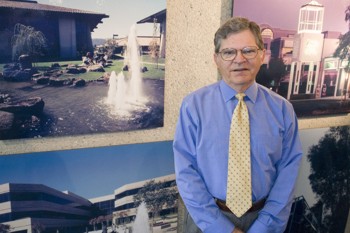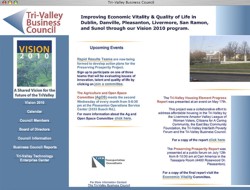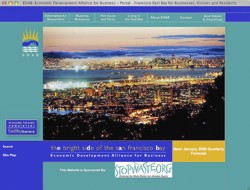Tri-Valley Business Council, Economic Development Alliance for Business Pursue Economic Development Missions for the Region and the East Bay
Tri-Valley Business Council, Economic Development Alliance for Business Pursue Economic Development Missions for the Region and the East Bay
Much of the emergence of the Tri-Valley and East Bay as economic powerhouses has come in the last 25 years, as the growth of the Bay Area overflowed its traditional boundaries and companies began moving their operations to Hacienda and other developments.
While the region has made a reputation for itself as one of innovation and entrepreneurship, a new challenge is emerging: continued economic prosperity. While local governments play an important role in meeting this challenge - see the February, 2005 issue of Network for a story on Pleasanton's economic vitality programs, for example - there's an important role to be played by regional organizations such as the Tri-Valley Business Council (TVBC), which focuses on Danville, Dublin, Livermore, Pleasanton, and San Ramon, and the Economic Development Alliance for Business (EDAB), which represents Alameda and Contra Costa counties.
Tri-Valley Business Council
The TVBC is no newcomer to regional economic development. The group was founded in 1994 with a simple but profound goal:
"Our mission is to represent the private sector in regional issues that impact economic vitality or the quality of life within the Tri-Valley. We work as facilitator with government and community to resolve issues. Our policy committees do research, track public policy, participate in public hearings, and act as a facilitator with governmental and community representatives to resolve issues."
Since then, the TVBC has worked on a variety of issues. Their first major work was 1997's Tri-Valley Economic Vitality Project, which was followed in 1998 by the Vision 2010 Project, a year-long process which involved over 200 government, business, and community leaders and resulted in a landmark strategic plan that set out specific recommendations in areas such as economic vitality, education, community planning and housing, agriculture and open space, and regional mobility.
The group's most recent accomplishment is Preserving Prosperity in the Tri-Valley, a 56-page report which provides a snapshot of recent economic conditions in the area and proposes a variety of possibilities for implementing the report's findings.
The report begins with a characterization of the past decade of growth in the area, which included increased industry specialization in software development and support, communications services and support, and scientific and biomedical devices and materials. These roles were played largely by well-established national and international companies which opened new facilities in the area.
The study continues by assessing more recent changes in the region's economy, which has evolved into what it describes as "a mix of industry specializations driven by a surge in homegrown entrepreneurship." The Tri-Valley has arrived at an exciting destination as a high-quality, innovation economy, one that serves as a birthplace for new ideas and depends on constant creativity, among other qualities, to create a competitive advantage.
The challenge facing the Tri-Valley, the report concludes, is maintaining and building on this success. An innovation economy depends on a number of raw materials: highly educated talent, a constant flow of ideas and resources for business creation and innovation, and a superb quality of life. Take away any one of these ingredients and the economy can begin to falter or, worse yet, business innovators could simply choose other locations. Fortunately, the TVBC is already taking steps to incubate these attributes.
"One of the things we decided to do was develop a regional economic strategy that focuses on our status as a center of innovation and entrepreneurship," says Tom O'Malley, president of the TVBC. "To address that, we formed a group that we call the Executive Roundtable, which is a mix of about 40 government, business, and service organization leaders, including each of the mayors and city managers in the area. We've had people come in who are experts in innovation to talk about the global aspects of innovation and why we need to be sure that we're competing globally.
"We then put the proposition out, particularly to the mayors and Alameda County Supervisor Scott Haggerty, that we need to sit down and develop a strategy that addresses these issues on a regional basis, and they agreed to move forward. So the challenge for us is to come back by June in front of that same group of people and show them some of the elements. If we wanted to do a regional strategy, what does that involve? What would we recommend? So we have a task force now that's looking at what other regions have done that have developed innovation as their theme."
The TVBC's approach is to first examine the needs of the area's existing businesses. "We need to understand more about these companies before we can recommend a strategy: who are they, what are their products, how many people work there, what are their growth plans, and what are their needs, be it in education, governmental assistance, networking with other firms, research or technology partnerships, and so on."
They have divided the region's corporations into four categories: information, biomedical/scientific, innovation services, and business services. Characterization of the information industry is going on now, with a team of MBAs from UC Davis conducting both an online survey and telephone interviews of CEOs.
"Now that we've gone through that and developed a survey form and a format for interviewing, we'll follow up with biomed, innovation services, and business services so that we understand each one of those areas before we start recommending economic policies," O'Malley says.
The TVBC is working on other aspects of the plan as well.
"We're trying to do some outreach to the national labs to understand what, if any, research and technology partnerships they may be interested in. We're also interested in what companies they're already doing partnerships with, and if any of those are out of the area, finding out if we can attract some of those partners to the Tri-Valley with a small office."
The TVBC is also addressing workforce issues. "If, in fact, you're going to be an innovative region, then the real key to that is that you have the right workforce and that the workforce has the skills that are needed by these companies and also that they're able to recruit and relocate people into the Tri-Valley. We're also working to understand the education needs in this area."
While the task of creating a regional consensus on economic development can be a daunting one, O'Malley is confident that it can be done and points at his group's track record as proof.
"We did the same kind of a study in 1997, and one of our weaknesses then was that we didn't have enough business services in the region - companies that were relocating into the area were still using their CPAs and legal and various business services from Silicon Valley or San Francisco, and they felt that we didn't have a core of people that were engaged in those types of businesses. But look at us now - we have somewhere around 14,000 people regionally that are engaged in that sort of activity, so we've gone from it being a weakness to being kind of an overwhelming strength in the region."
Economic Development Alliance for Business
While the TVBC focuses on the Tri-Valley, EDAB's work encompasses Alameda and Contra Costa counties: the entire East Bay. While the group's staff is composed of Alameda County employees, their funding comes from their members: over 20 cities in the region and over 100 other organizations ranging from labor to private businesses to non-profits.
"What we do is we sort of fill a niche between city economic development efforts and, say, the state economic development effort," explains Robert Sakai, EDAB's technology and trade director. "Many times there are issues that are more at the regional level, for instance jobs and housing, goods movement, and regulatory issues."
A major focus of EDAB's work is marketing the East Bay. "I've met with the Japan External Trade Organization many times, and each new director that comes in has a very specific concept of what San Francisco is, they really know what Silicon Valley is, and they all want to spend a weekend up in Napa. But they have no idea what the East Bay is, so we tell them this is UC Berkeley, which they know very well, and this is Chevron, and this is Safeway and Chiron and Pixar. You start rattling off all these companies and they come to understand that this is a very important economic region and an important part of the Bay Area.
"If you just take an individual city, you can't make the same case that you can for the East Bay as a region. The East Bay in aggregate has tremendous resources, and when you point those out to people in Japan or the trade delegations that come from China or Germany or Scotland, they're impressed. There is more biotech in the East Bay than there is in San Diego, which is considered a huge biotech powerhouse.
"We sell the Bay Area and once they're hooked on the Bay Area, then you tell them the role of the East Bay: we supply a significant part of the work force that works in Silicon Valley and in San Francisco, and we also have almost 40 percent of the future potential housing stock for that workforce. We are also the conduit for all the Central Valley labor that comes into the Bay Area, which means that a lot of companies have moved substantial facilities over here to retain the workers that they already have who come from the Central Valley or elsewhere in the East Bay, and, if they're in growth mode, to attract more workers coming out of the Central Valley. If you can build a case for the Bay Area, then you can build a good case for the East Bay. If they get sold on the East Bay, then they can decide which city they want to be in in the East Bay."
EDAB does more than marketing, however. They are the largest single issuer of Industrial Development Bonds (IDBs) in the state, giving manufacturers who meet specific criteria below market rate loans for up to $10 million. They helped the City of Pleasant Hill write an economic development strategic plan.
"We've written a biotech scoping document for the City of Fremont, suggesting how they might approach biotechnology as an economic development opportunity: what are the risks, what are the opportunities, what are the pitfalls, those sorts of things," adds Sakai. "We are also a network of networks, which means that if there's some other kind of economic development issue and you need someone to represent the region, we can perform that function. We can also get people in touch with the appropriate people most of the time because they're represented on our board of directors."
EDAB is also a great source of data on the East Bay, publishing quarterly reports prepared by economists at the UCLA Anderson Forecast analyzing the regional economy as well as aggregate data from the state Employment Development Department on a monthly basis. "We also do an annual report on economic indicators in the East Bay, which is available on our web site," Sakai says.
Getting Involved Both the TVBC and EDAB welcome new members and provide a wealth of material for download at their web sites. For additional information on the TVBC, contact Tom O'Malley at (925) 890-1892 or e-mail tjomalley1@aol.com. The group's web site may be found at www.trivalley.org. Executive director Bruce Kern is available for queries about EDAB. He can be reached at (510) 272-3874 or at bkern@edab.org. EDAB's web site is at www.edab.org.
Photo: Tom O'Malley, president of the Tri-Valley Business Council, is working on a regional strategy to enhance the area's future prosperity.
Also in this issue...
- Standard Pacific Homes Expands Hacienda Offices
- Edward Jones Looking for Long-Term Investors
- Business Bits
- Executive Profile: Steve Ganesh is Redefining the Technical Staffing Industry
- Pixion's PictureTalk Web Conferencing Application to Add Conference Podcasting
- BKF Engineers Finds Creative Solutions for Complex Problems
- Tri-Valley Business Council, Economic Development Alliance for Business Pursue Economic Development Missions for the Region and the East Bay
- Parent Education Classes Offer Insight, Understanding on Childrearing Issues
- Tri-Valley YMCA Provides a Multitude of Programs for Area Boys and Girls
- MasterCPR Offers Special Rates on First Aid, CPR Certification Courses for Hacienda Tenants
- Hacienda Index
- Calendar







